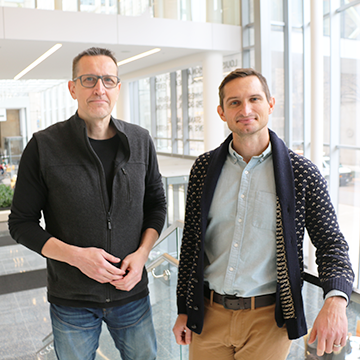Collaboration Leads to Innovative Clinical Trials Randomization
Designing a large-scale research study often requires creativity and a collaborative mindset. Fortunately, the all2GETHER team had both. When REDCap — the secure database commonly used by academic institutions for clinical trials — did not offer a way to use covariate-adaptive randomization algorithms (CARAs), researchers realized they would have to build their own software pipeline.
“With CARAs, you can ensure your treatment and control arms are comparable on important baseline measures,” says Jacob Schauer, PhD, assistant professor in Biostatistics in the Department of Preventive Medicine.
CARAs were first proposed in the 1970s to protect against a phenomenon statisticians call “accidental bias,” in which study arms can systematically differ just by chance in randomized controlled trials (RCTs). They work by randomizing participants in a manner that reduces existing differences between study arms and increases precision of clinical trials. Despite their effectiveness, CARAs are not commonly used in RCTs for several reasons, including a lack of readily available software.

When people come together like this, it's one of the hallmarks of good CTSAs ... It was really a classic approach to collaboration.”
Schauer is the statistician who developed the pipeline to deploy a CARA for the all2GETHER study, a couples-based intervention focused on reducing HIV transmission risk through management of relationships. Study participants were tested for sexually transmitted infections (STIs) at baseline, with results partly influencing which study arm they joined. STIs were one of the study’s covariates, or characteristics that are not the focus of a study but can influence outcomes.
For the all2GETHER study, Schauer knew a CARA would be beneficial, but the team needed a way to automate the randomization process. That’s where IT solutions architect Marc Broxton came in.
“It was really a classic approach to collaboration,” he says. Typically working on the administrative backend of REDCap, Broxton read the study documentation and discussed objectives with Schauer. Broxton explained, “REDCap sends an automated HTTP POST request with parameters in the query string. We needed something to receive the POST request and parse those parameters, so I spun up a web server.”
“When people come together like this, it's one of the hallmarks of good CTSAs,” says Schauer. NUCATS is part of the Clinical and Translational Science Awards (CTSA) program that supports translational research while fostering collaborations among academic institutions that will improve the efficiency, quality, and impact of the process for improving human health.
Without server automation, Schauer would have had to manually run the code for each new participant. Instead, the team was able to seamlessly randomize individuals into the study and troubleshoot any issues that arose. The study design also allowed covariates to be adjusted in real time if the arms started to become unbalanced.
All too often we design research methods around ‘ideal’ circumstances, but if interventions have a chance of being implemented in the community, we need technical solutions that allow us to design with future implementation in mind.”

Using the novel software, All2Gether was able to randomize approximately 2,100 participants in the study. “We have been able to complete 6- and 12-month follow-ups and will be continuing 12-month follow-ups until early 2026,” says Michael Newcomb, PhD, associate professor in Medical Social Sciences and principal investigator of the study.
“The design provided a framework that didn't previously exist in REDCap at Northwestern and is pretty easy to modify for other study designs,” Schauer says.
“All too often we design research methods around ‘ideal’ circumstances, but if interventions have a chance of being implemented in the community, we need technical solutions that allow us to design with future implementation in mind,” Newcomb added.
In the spirit of open science, the team made the code and instructions for using it available for all in GitHub, a platform for storing and sharing code. At least two additional clinical trials teams are now using the pipeline. What started as an idea for a single study grew into a collaboration that has expanded to other researchers.
“The key lesson for me is that this work is only possible through interdisciplinary collaboration, and that's the bread and butter of clinical and translational science,” Schauer says.
Written by Eva Winckler




